The L/B value is based on the Median Useful Life (Lx) which was introduced by the IEC. Median Useful Life is defined as the total operating time at which, under normal conditions, 50 percent of any large group of initially installed products is expected to still being operating. The L/B value is actually short for Lx/By, where x is the percentage value of initial lumens and y is the percentage value of initially installed products. Since Median Useful Life is by default based on a time interval after which half of the installed products will fail due to low light output, it is generally expressed without the B50 notification, though good practice would be to mention the this value. Median Useful Life L90, for example, is understood as that the length of time during which 50% (B50) of a particular group of products have their light output dropped to less than 90% of their initial luminous flux. L90 50,000 hours means within these 50,000 hours no more than 50% of the products achieve less than 90% of their original luminous flux.
The L/B value was originally intended to specify the drop in luminous flux of lamps of various types e.g. HID, fluorescent and halogen lamps. For LED light sources, lifetime has typically been considered to be the lumen maintenance life (Lp). LEDs typically have a very long service life when they’re operated within prescribed temperature limits and in controlled environmental conditions. The natural lifespan of LEDs ends in a wear-out mechanism. The wear-out mechanism occurs as a result of semiconductor failures and package failures such as nucleation and growth of dislocations in the active region of the diode, dopant diffusion, electrical contact metallurgical interdiffusion, delamination, encapsulant yellowing, and phosphor thermal quenching. Over time these degradation mechanisms lead to irreversible reductions in the light output of LEDs. Since it’s impractical to obtain meaningful experimental data relevant to real applications, the industry prescribed approaches to provide insights regarding the luminous flux maintenance behavior of LEDs and predict the wear-out life. Lumen maintenance life, which is projected per the IES TM-21, refers to the elapsed operating time at which the specified percentage of lumen depreciation or lumen maintenance is reached. It is defined as Lp where p is the percentage of initial light output. The Lp value is extrapolated from a shorter duration test based on the IES LM-80 method.
It’s generally accepted that a light output of 70 percent of initial lumens is the threshold for human perception of changes in light levels. Because of this, the generally accepted lifetime metric for LED light sources is L70. However, in many high end applications L70 may not be adequate and lighting manufacturers choose to report L80 and/or L90 values. Similarly, the median time, B50, may be unacceptable in some target markets. This leads to the use of B10 which denotes the time by which 10% of the population is expected to fail. Therefore the L90/B10 specification with 50,000 hours means that no more than 10% of the LEDs achieve less than 90% of their initial luminous flux within an operating period of 50,000 hours. The L80/B10 specification with 60,000 hours means the luminous flux of no more than 10% of all LEDs reduces to less than 80% of the initial lumens within these 60,000 hours. L70/B50 90,000 hours means 50% of the LEDs have at least 70% lumen maintenance for the projected 90,000 operating hours.

